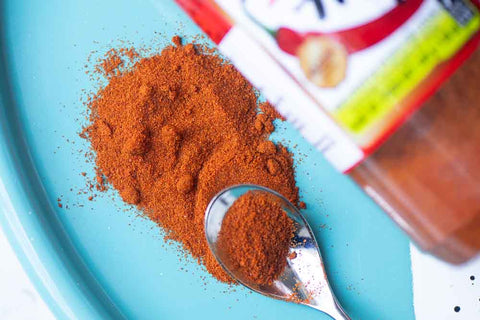Gochugaru vs Gochujang
by Jannika Resido

In Korean cuisine, two key ingredients often take centre stage: gochugaru and gochujang. These ingredients aren't just staples; they're the heartbeat of Korean flavours. Gochugaru, the chilli flakes, and gochujang, the savoury chilli paste, add the perfect kick to countless dishes.
In this blog, we’ll walk through exactly what sets them apart and why they're the must-haves in Korean kitchens!
What is Gochugaru?

Gochugaru, the fiery cousin in the Korean culinary duo, is essentially chilli flakes with a personality. These vibrant red flakes bring both heat and a touch of sweetness to the table. View it as the spice behind kimchi's bold kick or the secret ingredient in your favourite bulgogi marinade.
Gochugaru isn't just a one-size-fits-all either; there's a spectrum of spice levels to choose from. So you can dial up or down the heat according to your taste buds.
Whether it's sprinkled on barbecue meat and seafood or stirred into stews - gochugaru is the spice that elevates every bite.
Gochugaru versatility makes it a great ingredient to experiment with, you can find a use for it in everything from hearty stews to tangy pickles. The beauty of gochugaru lies in its adaptability; a sprinkle for a subtle kick or a generous amount for the bravest taste buds.
As you explore Korean cuisine, you'll find that gochugaru is the magic touch that transforms ordinary dishes into Korean cooking.
What is Gochujang?
Gochujang, the bold companion to gochugaru is a thick, crimson paste. It brings a savoury umami punch with a hint of sweetness to your dishes. It's not just a condiment; it's a culinary powerhouse, turning ordinary meals into a dance of sweet and spicy notes. Use it as the secret sauce in your favourite bibimbap or the hero of your spicy tteokbokki. Gochujang is the kind of friend you want in your kitchen, ready to add depth and character to any dish.
Just like its chilli-flake counterpart, gochujang comes in different varieties, each with its own flavour profile. From mild to extra spicy, it's all about finding the one that matches your taste buds' rhythm.
Whether you're dipping, glazing, or marinating, gochujang is the go-to sauce that effortlessly transforms your cooking into a Korean flavour extravaganza.
Differences Between Gochugaru and Gochujang
Gochugaru and gochujang might sound a little similar, but they bring their own unique roles to different recipes. Crucially, gochugaru is dry. They are the sprinkles of spice that add a kick to stews, soups, and kimchi.
On the flip side, gochujang is a thick and savoury paste. It adds body and texture to recipes, as well as flavour. Imagine creating a finger-licking barbecue sauce by whisking gochujang with soy sauce, garlic, and a hint of honey.
Physically, gochugaru is a flake, while gochujang is smoother, denser. Flavor-wise, gochugaru delivers a direct heat, like a bold chilli punch, while gochujang balances that heat with a complex mix of sweetness and umami.
In the kitchen, you might sprinkle gochugaru for a burst of spice or swirl in gochujang for a flavour bomb that lingers.

About the author
Jannika Resido is Sous Chef's online content specialist. She is an expert in southeast Asian food and ingredients! Jannika has several years of experience writing blogs and features for online publications. She loves savoury dishes, trying new ingredients (especially the fruity ones!) and discovering recipes from across the world.


